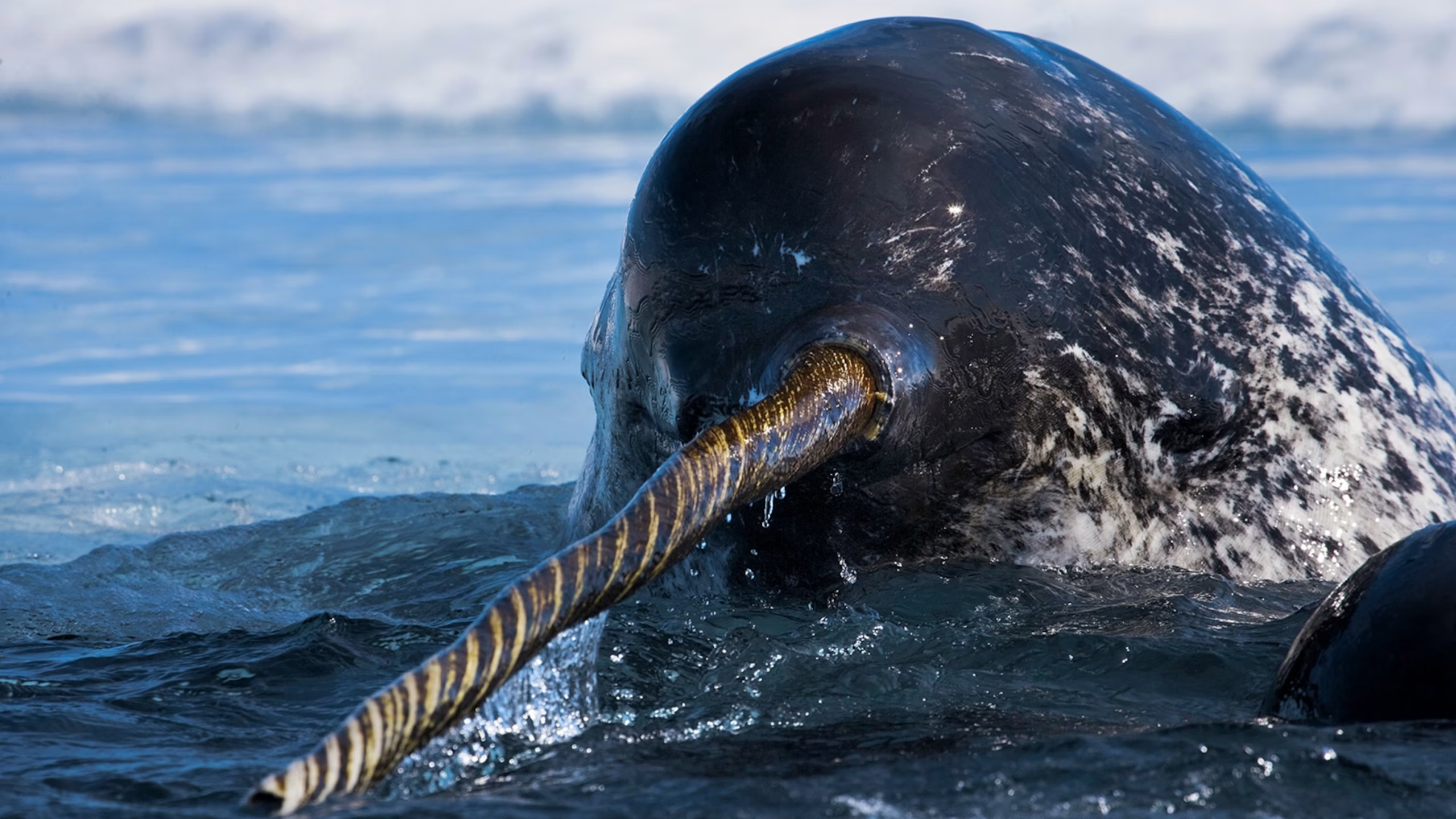The Enigmatic Narwhal: The Unicorn of the Sea

Introduction: The Mystery of the Narwhal
The narwhal, often referred to as the “unicorn of the sea,” is a creature shrouded in legend, mystery, and scientific intrigue. With its long, spiraled tusk, this Arctic dweller seems like a blend of a mythical creature and a real-life marvel. But this tusk, reaching lengths of up to 10 feet, is far from a fanciful adornment—it’s a highly sensitive organ that plays a crucial role in the narwhal’s survival.
For centuries, people have been captivated by the narwhal’s mystical appearance, often drawing comparisons to the unicorn in folklore. However, this creature’s biological and ecological significance is much more than that of a simple myth. In this article, we will uncover the truth behind the narwhal’s striking tusk, its unique lifestyle, and its critical role in the Arctic ecosystem.
Section 1: The Narwhal’s Mythical Tusk
A Tusk Like No Other: When most people think of narwhals, they immediately picture their long, spiraling tusks, which resemble unicorn horns more than whale teeth. The tusk is, in fact, a modified tooth that protrudes from the upper jaw of most male narwhals, though a rare few females also grow them.
How the Tusk Works: The tusk is not just a decorative feature. Recent research suggests that it contains around 10 million nerve endings, making it a highly sensitive organ. Scientists have compared it to a sensory tool, allowing the narwhal to detect changes in water temperature, salinity, and even the presence of prey. This gives narwhals a unique advantage in their icy environment, where visual cues are often limited.
Tusking Rituals: Male narwhals often engage in “tusking” behaviors, where they lightly spar with each other using their tusks. This behavior is thought to serve as a form of dominance display, particularly during the breeding season. The tusks can also be used to establish social hierarchies within narwhal pods, offering a glimpse into the social lives of these Arctic dwellers.
The Function of the Tusk: While the tusk is believed to play a role in communication and dominance displays, it’s also believed to help with navigation through the murky Arctic waters. Narwhals are known for diving deep into the ocean, and the tusk may help them sense their surroundings in these dark environments.

Section 2: The Narwhal’s Arctic Home
Adapting to Extreme Cold: Narwhals are uniquely adapted to life in the extreme conditions of the Arctic. These whales spend most of their lives in freezing waters, diving as deep as 1,500 meters (4,920 feet) to forage for food. They rely on sea ice for a portion of their existence, particularly in the Baffin Bay-Davis Strait region.
Living Beneath the Ice: During the winter months, narwhals seek refuge beneath the sea ice, where they rely on cracks and breathing holes to surface for air. These cracks are crucial lifelines for narwhals, as they provide the only access to oxygen in an otherwise impenetrable environment.
Survival in the Cold: Narwhals are able to dive to extraordinary depths—often more than a mile beneath the surface—using a special adaptation in their circulatory system that allows them to survive without oxygen for extended periods. This ability is critical when they are hunting for food, such as Greenland halibut, which lives on the ocean floor.
The Importance of Sea Ice: The loss of sea ice due to climate change poses a significant threat to narwhals. As the ice melts, narwhals are forced to adapt, but these changes can affect their behavior, migration patterns, and access to food sources.
Section 3: Narwhal Diet – What Do They Eat?
Specialized Diet: The narwhal’s diet primarily consists of Greenland halibut, which they hunt by diving deep into the ocean. These fish live in cold, deep waters, making them a perfect food source for the narwhals. However, narwhals also feed on other species, such as squid, shrimp, and other small fish.
Feeding Behavior: Narwhals are skilled hunters, using their deep-diving capabilities to reach the depths where their prey resides. This ability allows them to find food that many other Arctic animals cannot access. Their high sensitivity to environmental changes, aided by their tusk, may also help them locate these prey sources.
The Role of the Tusk in Feeding: Though it’s primarily known for communication and dominance displays, the narwhal’s tusk may also play a role in foraging. Some researchers believe that narwhals use their tusks to stir up sediment or fish, helping them find food more efficiently.
Nutritional Needs in the Arctic: In an environment as harsh as the Arctic, nutrition is key to survival. Narwhals need to consume large quantities of food to sustain their energy levels, especially during the winter months when hunting is more difficult.
:focal(-249x-171:-248x-170)/https://tf-cmsv2-smithsonianmag-media.s3.amazonaws.com/filer/cb/8e/cb8e2c03-9cd0-4c7f-8bdd-634cc2a02ea3/81021_orig.jpg)
Section 4: The Narwhal’s Social Structure – More Than Just a Myth
Pods and Family Groups: Narwhals are social creatures that live in groups known as pods. These pods are typically small and can consist of anywhere from a few individuals to over a dozen. Pods are usually made up of both males and females, though males tend to form separate groups during mating season.
The Role of the Tusk in Social Hierarchy: Within these pods, the tusk plays a critical role in establishing social dominance. During mating season, males engage in tusking behavior to demonstrate their strength and assert their position in the group. This display of dominance ensures that the most powerful males have access to mates.
Communication in the Deep: Narwhals are not silent creatures. While their tusks are an important tool for communication, they also use vocalizations to communicate with one another. These sounds, which can vary from clicks to whistles, are particularly useful in the dark waters where vision is limited.
Narwhals and Other Species: Although narwhals are known for their solitary nature, they also interact with other Arctic species, including other whale species and seals. This interaction can provide clues about the narwhals’ social dynamics and their relationship with other marine life.
Section 5: Why Protect the Narwhal?
Conservation Status: Narwhals are currently listed as a species of “least concern” by the International Union for Conservation of Nature (IUCN), but this does not mean they are without threat. The primary threat to narwhals is climate change, which affects both their habitat and food sources.
Climate Change and Habitat Loss: As the Arctic warms, sea ice is melting at an alarming rate. This loss of sea ice disrupts the narwhals’ migration patterns and their ability to find food. Warmer waters also affect the distribution of prey, forcing narwhals to travel further to find food.
Human Impact: In addition to climate change, narwhals face the risk of hunting, particularly by indigenous peoples in the Arctic. While these hunts are often conducted sustainably, illegal hunting poses a significant risk to the species.
Conservation Efforts: Organizations such as WWF are working tirelessly to protect narwhals and other Arctic species. These efforts include research on narwhal populations, protection of critical habitats, and raising awareness about the dangers of climate change.
Section 6: Fascinating Narwhal Facts – Did You Know?
More Than Just a Tusk: Narwhals are also known for their ability to make unique sounds that help them communicate and navigate through the dark waters of the Arctic. These vocalizations are a crucial part of their social interactions and foraging strategies.
Narwhals and Longevity: Narwhals can live for over 50 years, making them one of the longest-living whale species. Their long lifespan is a testament to their ability to adapt to the harsh conditions of the Arctic.

Section 7: How You Can Help Protect the Narwhal
Support Conservation: One of the most effective ways to help protect narwhals is by supporting conservation organizations that focus on Arctic wildlife. Donations and funding for research can go a long way in preserving these magical creatures.
Ethical Wildlife Watching: If you’re ever in the Arctic region, consider joining a responsible wildlife tour. These tours educate the public about narwhals while ensuring that they don’t disturb their natural habitat.
Conclusion: A Call to Action
The narwhal’s tusk is more than just a physical characteristic; it’s a key to understanding how these animals survive and thrive in one of the most inhospitable environments on Earth. As we continue to learn more about the narwhal’s unique adaptations and behaviors, it becomes clear that they are not just mythical creatures—they are vital to the health of the Arctic ecosystem.












